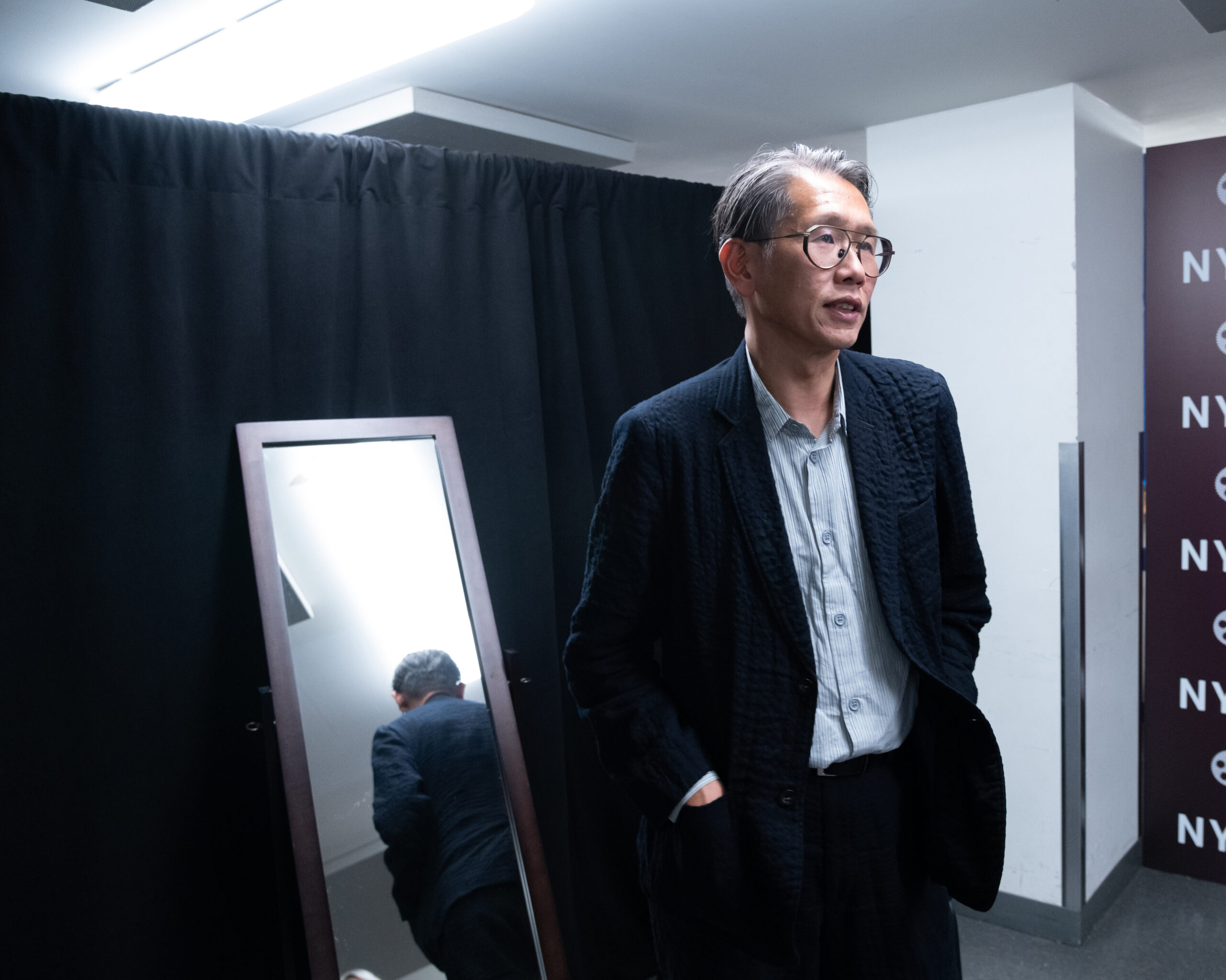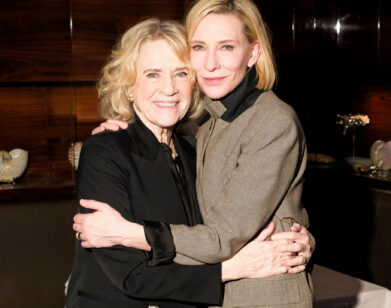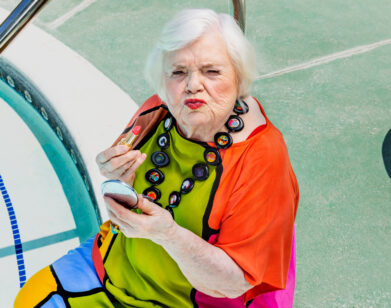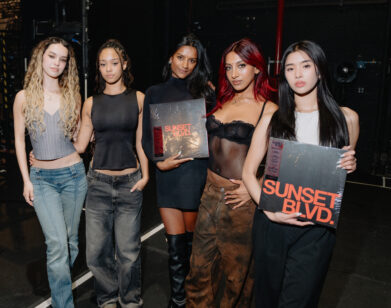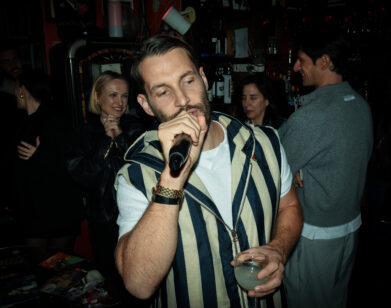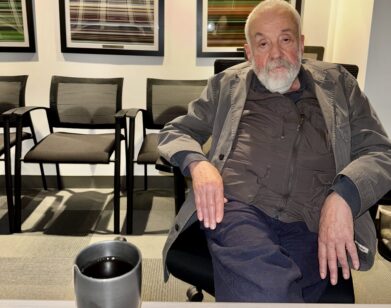NYFF
Curator Dennis Lim Takes Us Inside the 62nd New York Film Festival
MONDAY 4:19 PM SEPTEMBER 30, 2024 CAFE PARADISO
When Dennis Lim sits down to begin the yearlong process of programming the New York Film Festival, he does so with the intent of curating a balanced and variegated slate of films. But as he told Jeremy O. Harris earlier this week, this can manifest in different ways. “It’s important to have a balanced program, but there are many ways to look at balance,” said Lim, the festival’s artistic director who served as the director of programming at Film at Lincoln Center until 2022. “By balance, you could also say diversity, and that means diversity of not just gender and geography but also of forms and tones.” Lim and his team’s voracious appetite for cinema is reflected once again in this year’s program, which features everything from a 14-hour documentary by the Greek director Dimitris Athiridis to a formally innovative biopic of James Baldwin, not to mention Lim’s personal favorite: Misericordia, the latest feature from Alain Guiraudie. But one thing you won’t see at NYFF? The sort of rapturous, nine-minute-long standing ovations customary of festivals in Cannes and Venice. “I don’t think New Yorkers are into standing for that long,” Lim joked.
———
JEREMY O. HARRIS: Opening night was gorgeous.
DENNIS LIM: I’m glad you thought so.
HARRIS: I loved it. You said, “New York Film Festival is supposed to be a reflection of world cinema and, because of that, it’s now a reflection of the world.” That was very apt this week. Every year, we feel like the world is in a crazier place than it was the year before, but this year feels especially crazy for me. Seeing that so many films on the slate are so ambitious and formally daring, it’s saying something to me. But I wonder what it’s saying to you.
LIM: It’s really hard to know until after the fact. For me, I think when we’re in the process of putting the festival together, we’re really evaluating films on a case-by-case basis. But once the program starts to take shape, we begin to think more about how they might be in conversation with one another. I don’t think we look for themes, but the themes reveal themselves to us, or maybe to the audience. It’s up to people to connect the dots. I like your question, but I’m not sure if this idea of risk-taking is necessarily related to the state of the world. Do you think it is?
HARRIS: I mean, you look at the 1920s and the advent of surrealism and the literature that was coming out at that time. There was a major shift right after a major pandemic and a major world war. I think that there’s some correlation there. There’s a sense that, when the world becomes overwhelming and there’s too much stimuli, art starts to reflect that somehow.
LIM: I do think that there’s a correlation between dark and difficult times and interesting art, and certainly these films were made by filmmakers who live in the same world as us. We’re all responding to the same stimuli in some ways. But when we’re talking about the state of cinema, I don’t know that there’s a ton of reason for optimism if we look at just the structures, the systems. We’re living in a time that is increasingly hostile to art and to experimentation and to risk. I think that the program gathers exceptions to the rule. It tries to make the case that, however bleak things may be, there are always filmmakers who find a way. I think our program very deliberately runs the gamut and casts a wide net, geographically and formally. It’s interesting that you make that point about surrealism and the twenties. I wonder if artistic movements of that sort could still emerge today.
HARRIS: If trends can emerge, then a movement could as well, one would assume.
LIM: What are some of the trends you see, in this program or in general?
HARRIS: There’s the elevated rewrite or remix that I’m seeing a lot this year. Films like Anora and The Brutalist are really exciting, because they’re doing something similar to what PTA did with his love of [Robert] Altman and completely freaking it and making it his own. But you can still see the evidence of who was there.
LIM: The two films you mentioned, Sean [Baker] and Brady [Corbet] are deeply cinephilic filmmakers as well, maybe two of the most cinephilic filmmakers I know. So it makes sense to me that their films would be very intimately in conversation with the filmic traditions that they’re operating in. Brady talks about this a lot with The Brutalist. There’s something quite modern about the film, but it’s also very much a throwback film. There’s something classical about it.
HARRIS: There’s an intermission.
LIM: Yeah. He’s trying to channel a Hollywood epic of a certain era. But of course, the way people respond to it now is like, “Oh, it’s the kind of film that people don’t make anymore.” Or as he would probably put it, “The kind of films people aren’t allowed to make anymore.”
HARRIS: Totally.
LIM: It’s such an expansive and ambitious film, but it’s deeply personal as an allegory about art and money, art and patronage. I mean, it’s a film in which the artist is raped by his patron. And Brady’s talked a lot about just the difficulties of making a film of a certain size, of a certain scope, because cinema is expensive. That’s where the film is perhaps most personal.
HARRIS: It’s been easier for me to spot what we might call potential trends in some of the bigger movies, the ones made at major studios or being acquired by them. But the thing that draws me to New York Film Festival are the jewels that you find along the festival circuit that might struggle to find an audience. What are some of those movies, and do you see any trends in world cinema right now?
LIM: God, I’m the worst trend-spotter, I think.
HARRIS: You just set the trends, you don’t spot them.
LIM: It’s not up to me to identify them. I have my favorites, things that stand out to me, but I rarely forecast that. It’s disingenuous for me to say that I don’t have one. I definitely have filmmakers who mean a lot to me.
HARRIS: We all know one of them: Hong Sang-soo.
LIM: Yes. Somehow, he has picked up the pace of production—it used to be one movie a year, now it’s routinely two. When it comes to Hong, I think it’s incredible that he has the capacity to surprise even as the films are so deeply rooted in repetition and variation. But both of these films seem to be doing new things. In A Traveler’s Needs, the way he works with repetition is a little different. By the Stream is maybe the biggest departure for a recent Hong film in the sense that there’s so much more plot, so much more narrative stuff happening. Hong is somebody that me and my colleagues on the committee are all pretty committed to. There are filmmakers who I think have been consistently interesting. David Cronenberg, for instance, has never made an uninteresting film.
HARRIS: Absolutely.
LIM: That said, it’s been very important for us to refresh the slate every year and to welcome new voices to the festival. There was some statistic we put out when we announced the slate; apparently, 18 of 33 filmmakers in the main slate are new to it.
HARRIS: Wow.
LIM: I’m particularly excited about the line-up in the “Currents” section, which has some of the strongest films in the festival. I love Jem Cohen’s film, which is the centerpiece film of “Currents,” called Little, Big, and Far. It’s a really nice companion piece to this film from about 10 years ago called Museum Hours about an astronomer who’s in search of a dark enough night sky to study a star.
HARRIS: That’s beautiful.
LIM: I also love Yashaddai Owens’ Jimmy. You have to see this film. It’s a totally fresh and even exhilarating way to think about biography and portraiture. It’s a film that imagines the life of a young James Baldwin when he is newly arrived in Paris, and a film that completely and brilliantly dispenses with all the traps of biopics, which of course remains a very dominant genre in the realm of the prestige movie, where it often becomes about recreation, impersonation, a certain kind of embodiment. But Jimmy asks us to think about embodiment in a different way. And one of my favorite films of the year is this documentary called Exergue, which is a 14-hour film about the making of documenta 14, which took place in Kassel, Germany and Athens. It’s extraordinary, up there with the very best of Frederick Wiseman. It really gets into the intersection of art and money and politics in ways that I’ve rarely seen depicted in cinema. And for us, as the programmers of the festival, it’s a very relatable film.
HARRIS: So how does one begin to sit down for a 14-hour film?
LIM: We’re showing it in three parts, four or five hours a night. It’s a film you can dip in and out of because it’s episodic, although it’s optimally viewed from beginning to end. We also have two documentaries premiering in the main slate, Julia Loktev’s film My Undesirable Friends, about journalists In Russia working there up to the invasion of Ukraine, and Robinson Devor’s Suburban Fury, which is the portrait of would-be presidential assassin, Sarah Jane Moore, who is a very willing but also tricky subject, because she is clearly very happy to be the subject of this film and speak about her life and her exploits.
HARRIS: Are there any films that you or your team saw at one of the many, many festivals that happened around the world this year that you were like, “Oh, I wish we had been able to get that one?”
LIM: I mean, not so much. There were a few films that weren’t ready that we thought we might be able to see but had their start dates pushed partly because of the delays caused by the actors’ strike last year. For instance, we’d been hoping that Jim Jarmusch’s film would be ready, but it isn’t.
HARRIS: I think YSL produced it.
LIM: Exactly.
HARRIS: One of the films I’m most impressed with is Emilia Perez. I’m like, “YSL produced this?” That’s sick.
LIM: The Shrouds as well.
HARRIS: Oh, wow. On the filmmaker and producer side, it’s feeling like celebrity is becoming more and more important to all of these major festivals. It seems like there was a time when true independence ruled the day, but there’s a higher dependence, partly because of risk mitigation, on the import of celebrity. Is that something you guys think about>
LIM: It’s important to have a balanced program, but there are many ways to look at balance. By balance, you could also say “diversity,” and that means diversity of not just gender and geography but also of forms and tones. And that usually takes care of the celebrity thing, because we like to assemble as complete a picture as we can of the cinema that matters. We’re all believers in cinema being a popular art form, but also an art form that has the potential to challenge and unsettle. If you put all of that together, you’re going to have some big films and some small films, and the big films usually bring the celebrities. I’m happy that actors are free to come and present their films. Although last year, I have to say, a lot of people came up to us and said they were really happy to hear from craftspeople. We had editors, sound designers, costume designers, production designers coming on stage.
HARRIS: That’s what really thrills me about the co-engineered film festival and why I think it’s such a tip-hole of the city’s great offerings. It feels like a more European sensibility around what makes a film—it’s everyone. One of the things I loved when I went to a European festival for the first time was the amount of applause for filmmakers, no matter what the feeling on the film was. They recognized the amount of incredible labor it takes to put something on a screen.
LIM: You’re right in that New Yorkers are maybe not as effusive as the Venice audience that apparently likes to stand for 10 or 20 minutes at a time—
HARRIS: 30-minute standing ovation.
LIM: I don’t think New Yorkers are into standing for that long. I have gone to some of those Cannes [Film Festival] premieres where it seemed like, “Okay, when can we stop?”
HARRIS: I love the opera, but any space that demands your consistent applause, I’m like, “Guys, we get it.” Speaking of applause, I want to give you all of your applause for making my favorite festival. I really, really love it.
LIM: We love having you here.

